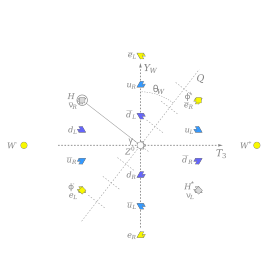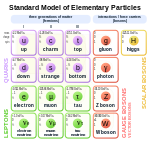
In nuclear physics and particle physics, the weak interaction, which is also often called the weak force or weak nuclear force, is one of the four known fundamental interactions, with the others being electromagnetism, the strong interaction, and gravitation. It is the mechanism of interaction between subatomic particles that is responsible for the radioactive decay of atoms: The weak interaction participates in nuclear fission and nuclear fusion. The theory describing its behaviour and effects is sometimes called quantum flavourdynamics (QFD); however, the term QFD is rarely used, because the weak force is better understood by electroweak theory (EWT).

The Standard Model of particle physics is the theory describing three of the four known fundamental forces in the universe and classifying all known elementary particles. It was developed in stages throughout the latter half of the 20th century, through the work of many scientists worldwide, with the current formulation being finalized in the mid-1970s upon experimental confirmation of the existence of quarks. Since then, proof of the top quark (1995), the tau neutrino (2000), and the Higgs boson (2012) have added further credence to the Standard Model. In addition, the Standard Model has predicted various properties of weak neutral currents and the W and Z bosons with great accuracy.
The Klein–Gordon equation is a relativistic wave equation, related to the Schrödinger equation. It is second-order in space and time and manifestly Lorentz-covariant. It is a quantized version of the relativistic energy–momentum relation . Its solutions include a quantum scalar or pseudoscalar field, a field whose quanta are spinless particles. Its theoretical relevance is similar to that of the Dirac equation. Electromagnetic interactions can be incorporated, forming the topic of scalar electrodynamics, but because common spinless particles like the pions are unstable and also experience the strong interaction the practical utility is limited.

Technicolor theories are models of physics beyond the Standard Model that address electroweak gauge symmetry breaking, the mechanism through which W and Z bosons acquire masses. Early technicolor theories were modelled on quantum chromodynamics (QCD), the "color" theory of the strong nuclear force, which inspired their name.
In particle physics, the W and Z bosons are vector bosons that are together known as the weak bosons or more generally as the intermediate vector bosons. These elementary particles mediate the weak interaction; the respective symbols are
W+
,
W−
, and
Z0
. The
W±
bosons have either a positive or negative electric charge of 1 elementary charge and are each other's antiparticles. The
Z0
boson is electrically neutral and is its own antiparticle. The three particles each have a spin of 1. The
W±
bosons have a magnetic moment, but the
Z0
has none. All three of these particles are very short-lived, with a half-life of about 3×10−25 s. Their experimental discovery was pivotal in establishing what is now called the Standard Model of particle physics.

The Minimal Supersymmetric Standard Model (MSSM) is an extension to the Standard Model that realizes supersymmetry. MSSM is the minimal supersymmetrical model as it considers only "the [minimum] number of new particle states and new interactions consistent with "Reality". Supersymmetry pairs bosons with fermions, so every Standard Model particle has a superpartner yet undiscovered. If discovered, such superparticles could be candidates for dark matter, and could provide evidence for grand unification or the viability of string theory. The failure to find evidence for MSSM using the Large Hadron Collider has strengthened an inclination to abandon it.

In the Standard Model of particle physics, the Higgs mechanism is essential to explain the generation mechanism of the property "mass" for gauge bosons. Without the Higgs mechanism, all bosons (one of the two classes of particles, the other being fermions) would be considered massless, but measurements show that the W+, W−, and Z0 bosons actually have relatively large masses of around 80 GeV/c2. The Higgs field resolves this conundrum. The simplest description of the mechanism adds a quantum field (the Higgs field) which permeates all of space to the Standard Model. Below some extremely high temperature, the field causes spontaneous symmetry breaking during interactions. The breaking of symmetry triggers the Higgs mechanism, causing the bosons it interacts with to have mass. In the Standard Model, the phrase "Higgs mechanism" refers specifically to the generation of masses for the W±, and Z weak gauge bosons through electroweak symmetry breaking. The Large Hadron Collider at CERN announced results consistent with the Higgs particle on 14 March 2013, making it extremely likely that the field, or one like it, exists, and explaining how the Higgs mechanism takes place in nature. The view of the Higgs mechanism as involving spontaneous symmetry breaking of a gauge symmetry is technically incorrect since by Elitzur's theorem gauge symmetries can never be spontaneously broken. Rather, the Fröhlich–Morchio–Strocchi mechanism reformulates the Higgs mechanism in an entirely gauge invariant way, generally leading to the same results.

The phrase Yang–Mills theory means both a quantum field theory for nuclear binding devised by Chen Ning Yang and Robert Mills in 1953 and the class of similar theories. In mathematical physics, Yang–Mills theory is a gauge theory based on a special unitary group SU(n), or more generally any compact Lie group. A Yang–Mills theory seeks to describe the behavior of elementary particles using these non-abelian Lie groups and is at the core of the unification of the electromagnetic force and weak forces (i.e. U(1) × SU(2)) as well as quantum chromodynamics, the theory of the strong force (based on SU(3)). Thus it forms the basis of our understanding of the Standard Model of particle physics.
In particle physics, the Peccei–Quinn theory is a well-known, long-standing proposal for the resolution of the strong CP problem formulated by Roberto Peccei and Helen Quinn in 1977. The theory introduces a new anomalous symmetry to the Standard Model along with a new scalar field which spontaneously breaks the symmetry at low energies, giving rise to an axion that suppresses the problematic CP violation. This model has long since been ruled out by experiments and has instead been replaced by similar invisible axion models which utilize the same mechanism to solve the strong CP problem.
In field theory, the Stueckelberg action describes a massive spin-1 field as an R Yang–Mills theory coupled to a real scalar field . This scalar field takes on values in a real 1D affine representation of R with as the coupling strength.
In quantum field theory, the theta vacuum is the semi-classical vacuum state of non-abelian Yang–Mills theories specified by the vacuum angleθ that arises when the state is written as a superposition of an infinite set of topologically distinct vacuum states. The dynamical effects of the vacuum are captured in the Lagrangian formalism through the presence of a θ-term which in quantum chromodynamics leads to the fine tuning problem known as the strong CP problem. It was discovered in 1976 by Curtis Callan, Roger Dashen, and David Gross, and independently by Roman Jackiw and Claudio Rebbi.

The weak mixing angle or Weinberg angle is a parameter in the Weinberg–Salam theory of the electroweak interaction, part of the Standard Model of particle physics, and is usually denoted as θW. It is the angle by which spontaneous symmetry breaking rotates the original
W0
and
B0
vector boson plane, producing as a result the
Z0
boson, and the photon. Its measured value is slightly below 30°, but also varies, very slightly increasing, depending on how high the relative momentum of the particles involved in the interaction is that the angle is used for.

This article describes the mathematics of the Standard Model of particle physics, a gauge quantum field theory containing the internal symmetries of the unitary product group SU(3) × SU(2) × U(1). The theory is commonly viewed as describing the fundamental set of particles – the leptons, quarks, gauge bosons and the Higgs boson.

Weak neutral current interactions are one of the ways in which subatomic particles can interact by means of the weak force. These interactions are mediated by the Z boson. The discovery of weak neutral currents was a significant step toward the unification of electromagnetism and the weak force into the electroweak force, and led to the discovery of the W and Z bosons.

Møller scattering is the name given to electron-electron scattering in quantum field theory, named after the Danish physicist Christian Møller. The electron interaction that is idealized in Møller scattering forms the theoretical basis of many familiar phenomena such as the repulsion of electrons in the helium atom. While formerly many particle colliders were designed specifically for electron-electron collisions, more recently electron-positron colliders have become more common. Nevertheless, Møller scattering remains a paradigmatic process within the theory of particle interactions.

In quantum electrodynamics, Bhabha scattering is the electron-positron scattering process:

Charged current interactions are one of the ways in which subatomic particles can interact by means of the weak force. These interactions are mediated by the
W+
and
W−
bosons.
In particle physics, the Peskin–Takeuchi parameters are a set of three measurable quantities, called S, T, and U, that parameterize potential new physics contributions to electroweak radiative corrections. They are named after physicists Michael Peskin and Tatsu Takeuchi, who proposed the parameterization in 1990; proposals from two other groups came almost simultaneously.

In physics, a gauge theory is a type of field theory in which the Lagrangian, and hence the dynamics of the system itself, do not change under local transformations according to certain smooth families of operations. Formally, the Lagrangian is invariant.
In nuclear physics and atomic physics, weak charge refers to the Standard Model weak interaction coupling of a particle to the Z boson. For example, for any given nuclear isotope, the total weak charge is approximately −0.99 per neutron, and +0.07 per proton. It also shows an effect of parity violation during electron scattering.









































































